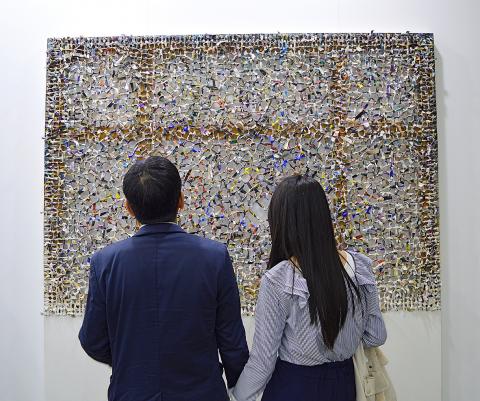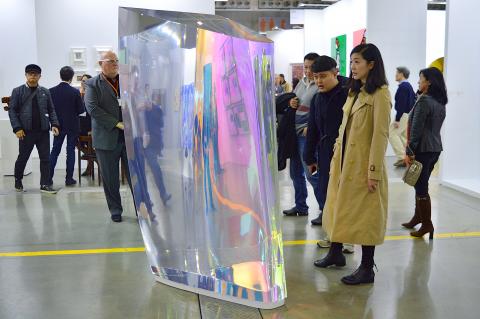Following the success of last year’s inaugural event, Taipei Dangdai (台北當代) is back for its second edition today through Sunday. The contemporary art fair presents renowned and young galleries, as well as solo exhibitions from the likes of Christopher Le Brun, recent president of the Royal Academy of Arts. The fair is complete with a salon section, where collectors can choose from artworks starting from US$8,000.
During this time, contemporary art will take over many sites in Taipei, including a light show at Taipei 101, designed by Tokyo-born Taiwanese artist Michael Lin (林明弘), from 6:30pm to 7pm every evening. Other off-site highlights include a major installation by Chinese artist Ai Wei Wei (艾未未) at Chambers Fine Art and Zhao Gang’s (趙剛) exhibition presented at Each Modern.
Ticket holders may attend talks with artists at Dangdai’s Ideas Program, focusing on the fair’s central themes: technology, ecology, pop and tradition. Highlights include a talk with Colombian artist Oscar Murillo, whose works focus on universal human experiences in an increasingly globalized world. Guided tours are also available in Chinese and English. Pre-booking is essential due to the limited number of participants per tour.

Photo: Ella Csarno
■ 1am to 6pm today and tomorrow, 11am to 5:30pm Sunday, Taipei World Trade Center Nangang Exhibition Hall (台北世界貿易中心南港展覽館), 1 Jingmao 2nd Rd, Taipei City (台北市經貿二路1號)
■ Advance tickets are NT$550 for today and NT$625 for tomorrow and Sunday, NT$750 at the door. For more information, visit /taipeidangdai.com

Photo: Ella Csarno

The canonical shot of an East Asian city is a night skyline studded with towering apartment and office buildings, bright with neon and plastic signage, a landscape of energy and modernity. Another classic image is the same city seen from above, in which identical apartment towers march across the city, spilling out over nearby geography, like stylized soldiers colonizing new territory in a board game. Densely populated dynamic conurbations of money, technological innovation and convenience, it is hard to see the cities of East Asia as what they truly are: necropolises. Why is this? The East Asian development model, with

June 16 to June 22 The following flyer appeared on the streets of Hsinchu on June 12, 1895: “Taipei has already fallen to the Japanese barbarians, who have brought great misery to our land and people. We heard that the Japanese occupiers will tax our gardens, our houses, our bodies, and even our chickens, dogs, cows and pigs. They wear their hair wild, carve their teeth, tattoo their foreheads, wear strange clothes and speak a strange language. How can we be ruled by such people?” Posted by civilian militia leader Wu Tang-hsing (吳湯興), it was a call to arms to retake

This is a deeply unsettling period in Taiwan. Uncertainties are everywhere while everyone waits for a small army of other shoes to drop on nearly every front. During challenging times, interesting political changes can happen, yet all three major political parties are beset with scandals, strife and self-inflicted wounds. As the ruling party, the Democratic Progressive Party (DPP) is held accountable for not only the challenges to the party, but also the nation. Taiwan is geopolitically and economically under threat. Domestically, the administration is under siege by the opposition-controlled legislature and growing discontent with what opponents characterize as arrogant, autocratic

Desperate dads meet in car parks to exchange packets; exhausted parents slip it into their kids’ drinks; families wait months for prescriptions buy it “off label.” But is it worth the risk? “The first time I gave him a gummy, I thought, ‘Oh my God, have I killed him?’ He just passed out in front of the TV. That never happens.” Jen remembers giving her son, David, six, melatonin to help him sleep. She got them from a friend, a pediatrician who gave them to her own child. “It was sort of hilarious. She had half a tub of gummies,